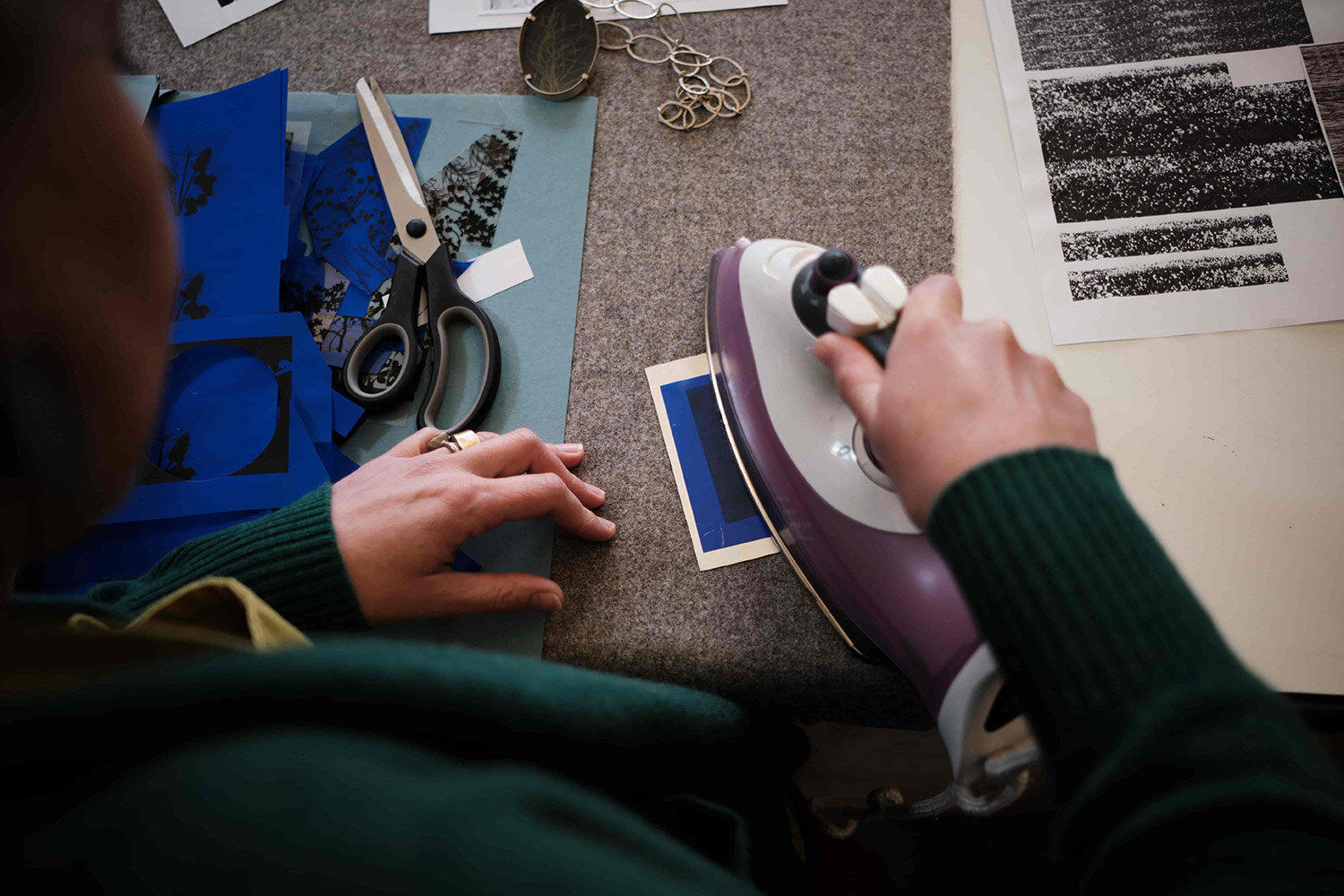Ethical Journey Case Study: Sally Grant
As part of our maker case study series, we speak to Burntisland based maker Sally Grant about her ethical making approach. Through this series of posts, we aim to highlight that ethical making isn’t an all or nothing approach, more often than not, the process is a journey.
Sally Grant in her workshop. Image by James Robertson
My love of design and craftsmanship has informed my work from the very beginning. I studied 3 Dimensional Design at Grays School of Art in Aberdeen. Following graduation I worked in a number of creative environments while establishing my jewellery business. These included marketing and creative direction with a design consultancy, gallery assistant and florist. During this period I undertook a two year apprenticeship with a renowned jeweller and Goldsmith, Tony Thomson in Oxford. It was here I learned the practical skills of making in precious metals, gold, silver and platinum and was properly introduced to the world of gemstones. Tony’s workshop was filled with a lifelong collection of unusual fossils and stones gathered from all over the world. This experience still informs my work today.
A selection of Sally’s tools. Image by James Robertson
Tell us about your work and approach.
I create jewellery predominately to commission, incorporating precious metals and gemstones. I have a limited edition and one-off piece collection available for sale through exhibitions and by appointment at my studio. I have exhibited my jewellery in galleries and exhibitions in the UK, Europe and America.
Exploring and re-interpreting the imagery and patterns found in natural landscapes using photography, hand carving and texturing techniques are central to my jewellery collections. The technique of photo-etching allows me to translate images into textural designs on precious metals.
I am also drawn to gemstones with unusual inclusions and formations that resonate with the images I collect. These stones are natural and unique and when combined with an etched pattern or a simple setting, they compliment each other.
My creative process is inherently linked to the skills and craft of making each piece and my commitment to honest, clear design principles and craftsmanship informs every piece that I make.
Images by James Robertson
When did you start thinking about taking steps to be more ethical in your business, was there a key moment?
Research early in my career informed me of the challenges faced by both the gemstone trade and gold mining. I have been following the pioneering work of Bario Neal Jewellery, industry leader in ethical sourcing in the USA since their launch in 2008. I began to question my work practice and I realised that we have a responsibility to know where the materials we use are from. That evidence seemed lacking in my early career. My work is about truth to materials and nature and I’ve made a point of tracking down materials that have the same truth and provenance, materials that are reflective of the values I apply to my designs. Sourcing ethical precious metals and gemstones is hugely important to me as it is the only way to guarantee the products that I am buying have come from a fully traceable and sustainable supply chain.
A selection of jewellery on permanent display in Sally’s workshop. Image by James Robertson
What steps have you taken on your ethical journey?
I am a member of the Fair-trade Goldsmiths scheme and I am committed to buying Fair-trade golds. The overall objective of the Fair-trade standard for gold is to create opportunities for artisanal and small-scale miners and their communities, empowering them to bring about change through trade, and delivering economic, social and environmental transformation and restoration. I am keen to buy gemstones which have been sourced with the same approach.
Tell us about your experience of making these steps.
As a small business, offering Fair-trade precious metals to my customers when it first became available was expensive as choices were limited and suppliers offered the metals with minimum order conditions. Today, Fair-trade golds are much more readily available. I have refined my work practice to utilise the materials available. In recent years, Fair-trade and ethically sourced diamonds and gemstones have become more accessible to jewellers in the UK and I now regularly use them in my work.
Rock texture detail for a hand carved textural ring design. Image by James Robertson
Why do you think it is important to take these steps, make these changes?
It is absolutely necessary for all makers to understand the importance of ethics and sustainability in their work. I would encourage all makers to follow the UN Sustainable Development Goals to understand the need for change and to learn of ways that they can apply changes to their practice. It is important to remember that small changes can make a huge impact.
What challenges have you faced in regards to ethical making and what areas do you think need improved to support your ethical making journey?
The diamond and gemstone industry requires significant improvement and more transparency in the supply chain.
What are your ethical making plans for the future?
I will continue to offer Fair-trade golds to my customers.
I recently made a ring for Elements Festival incorporating a MOYO gemstone. The stone was sourced via a pilot scheme introduced in Tanzania to empower women miners to work safely, mine better, improve financial security and create stable, equitable markets for trade. An an estimated 30% of artisanal and small-scale miners are women. Tanzania, Kenya, Zimbabwe, Ethiopia, Malawi, Madagascar, and Ghana have particularly high numbers of women miners. At the heart of the pilot project are the Tanzania Women Miners Association (TAWOMA) supported by the Gemological Institute of America (GIA), the international development agency PACT alongside Anza Gems and Nineteen48 Gemstones. I think it’s very important that these women are supported and they are given a voice and an equal platform from which to work and trade. The organisation also helps with education and this is also a key factor in providing equality for them.
Sally Grant 18ct Fairtrade Gold ring featuring a MOYO garnet. Image by James Robertson
The MOYO gemstones have only recently become available to purchase, the gemstone I have bought is from this first collection. I know that the pilot has been a huge success – the future of the programme relies on this continued support. I plan to create a collection of pieces inspired by the miners story to give my customers the opportunity to have a deeper connection with the places and the people living and working where the jewellery supply chains begin.
Thank you Sally for sharing your ethical journey with us.
For more information about Sally Grant:
All Images by James Robertson










